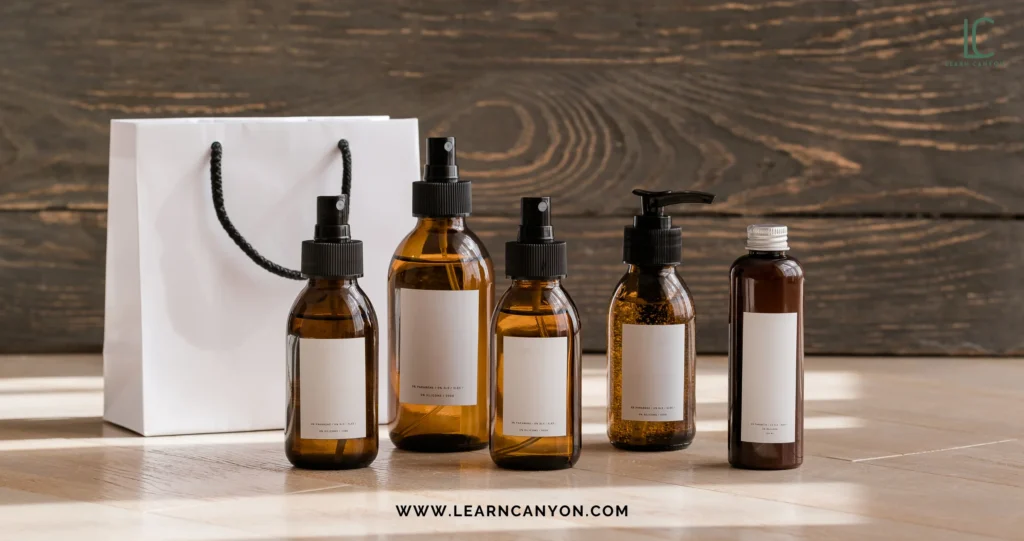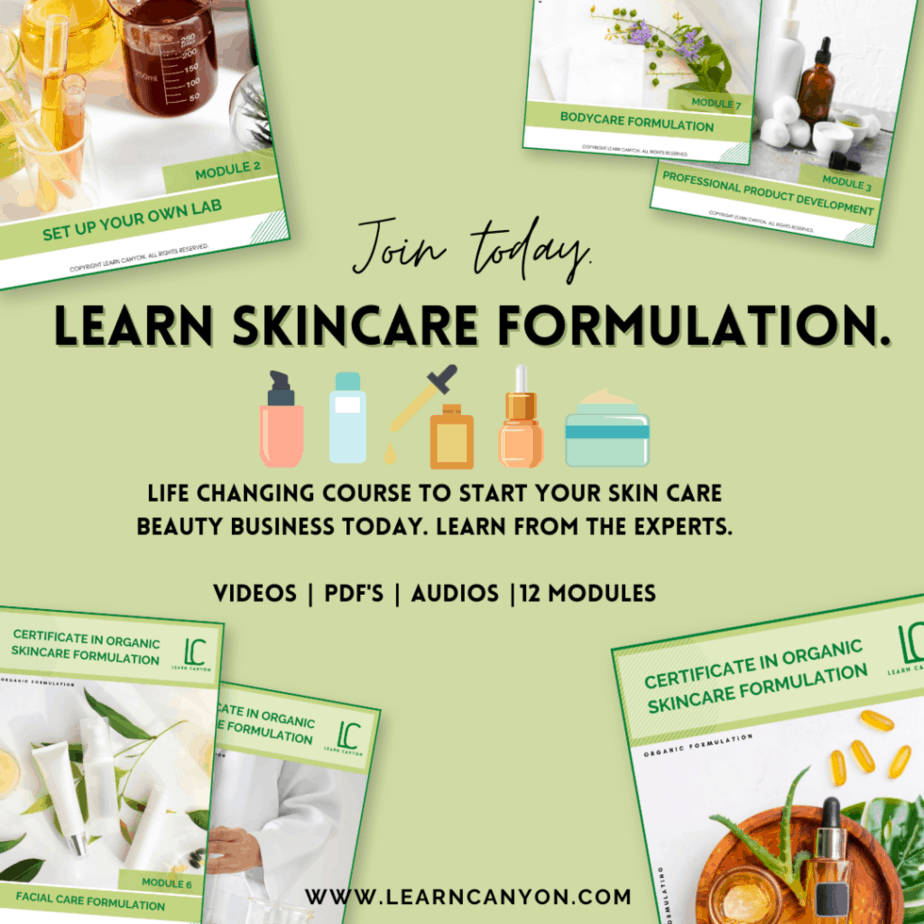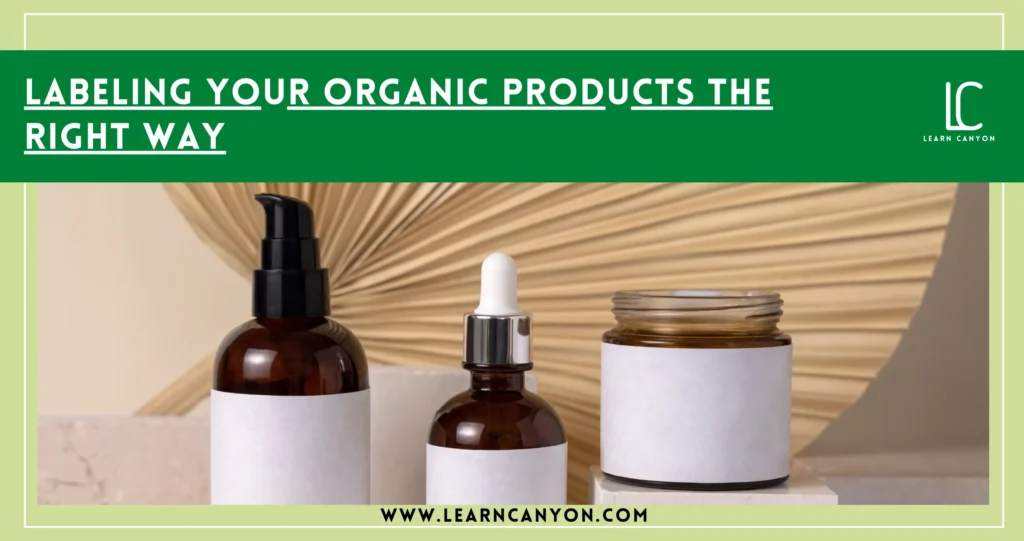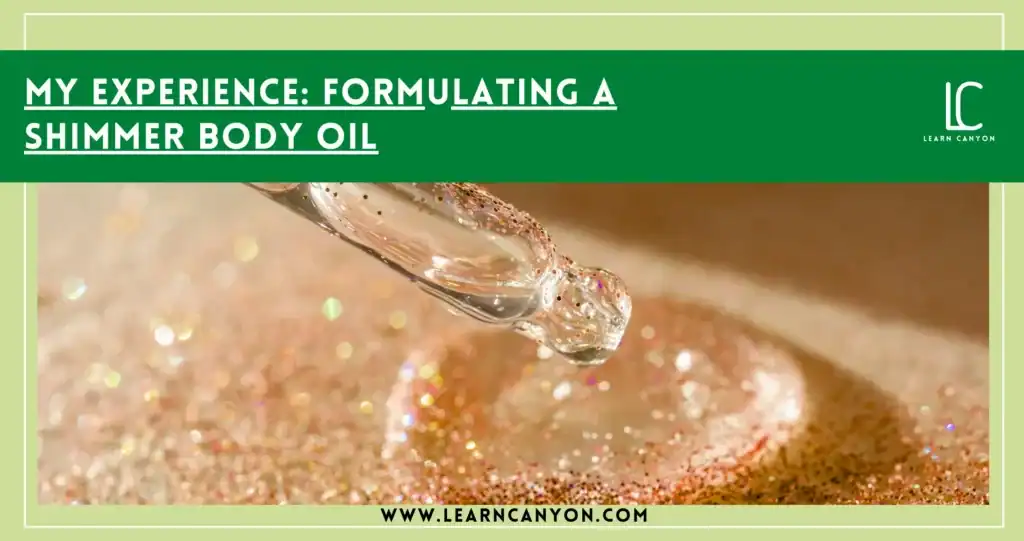Labeling organic products isn’t just about slapping a pretty name and a leaf icon on your bottle and calling it a day.
As a professional formulator, I’ve seen too many brilliant creators, especially those diving into the world of organic skincare, get tripped up by the fine print of compliance. Whether you’re selling at a local market, launching your own brand, or dreaming of going global, your label is more than packaging… it’s your promise.
It tells your customers what your product stands for, what it’s made of, and why they can trust you.
But here’s the truth: terms like “organic,” “natural,” and “clean” come with real responsibilities. And if you want your products to shine in a crowded market (without getting flagged or fined), understanding labeling laws and transparency is non-negotiable.
In this guide, I’ll walk you through the essentials, everything you need to know about labeling your organic products the right way. No jargon. No confusion. Just clear, practical steps you can implement right now.
Let’s get into it.
What Does “Organic” Really Mean in Skincare and Cosmetics?
Let’s clear the air, because the word “organic” gets tossed around a lot these days, and not always in the right way.
When we talk about organic in skincare and cosmetics, we’re referring to ingredients that are grown without synthetic pesticides, herbicides, genetically modified organisms (GMOs), or harmful chemicals. But here’s where it gets tricky: just because an ingredient is natural doesn’t automatically make it organic.
For example, lavender essential oil is natural, but unless it’s sourced from certified organic farms, you can’t label it organic. See the difference?
As a formulator, this is where we need to be crystal clear. Not only for regulatory reasons, but because your customers are looking for transparency. They want to know that what they’re putting on their skin is clean, safe, and ethically made.
Also, remember: in cosmetics, the word “organic” doesn’t just apply to the ingredient itself. It must align with the overall formulation. Most organic certification bodies require a specific percentage of certified organic ingredients in your final product before you can make certain claims on your label.
Think of it like this, organic is a commitment, not a buzzword. And once you understand what it truly means, you can formulate with purpose, label with confidence, and build real trust with your audience.
Regulatory Bodies and Standards to Know
Okay, now that we’ve unpacked what organic actually means, let’s talk about who gets to decide how you use that word on your product labels.
This is where certification bodies come in, and trust me, as a formulator, understanding them is a must if you want to stay compliant and credible.
There’s no single global standard for what qualifies as “organic” in cosmetics (I know, frustrating, right?). But several well-respected organizations set the rules based on your region, and each has its own criteria for how much of your product must be certified organic before you can make specific claims.
Let me break down the key players for you:
USDA Organic (United States)
If you’re in the U.S. or selling there, this is the gold standard. USDA certification means:
- 100% Organic: All ingredients must be certified organic.
- Organic: At least 95% organic ingredients.
- Made with Organic Ingredients: At least 70% organic, but you can’t use the USDA seal.
And yes, they’re strict, but it’s totally worth it if you’re aiming for clean beauty cred.
COSMOS (Europe & International)
COSMOS is a globally recognized standard supported by Ecocert, Soil Association, BDIH, ICEA, and others. Their certification allows for:
- Certified organic: Minimum 95% of plant-based ingredients and 20% of the total formula must be organic (10% for rinse-off).
- Certified natural: Focused more on natural origin but doesn’t require the same organic percentage.
COSMOS also evaluates your packaging and sustainability practices. A big plus if you’re eco-conscious!
Ecocert (France, Global Reach)
Ecocert is one of the founding members of COSMOS. It offers both:
- Natural Cosmetic certification
- Organic Cosmetic certification

With requirements similar to COSMOS, but still issued under the Ecocert logo.
ACO (Australia)
Australian Certified Organic is popular in the Asia-Pacific region. It follows strict guidelines for ingredient sourcing and manufacturing processes and is well-respected internationally.
🇮🇳 India Organic / NPOP (India)
If you’re formulating or sourcing from India, this is the official national standard. It’s primarily agricultural but can apply to herbal and botanical raw materials used in cosmetics too. However, for product certification, Indian brands usually rely on COSMOS or USDA for better global acceptance.
Each of these bodies has its own application process, fees, and inspection systems. You don’t have to get certified to label your products truthfully, but if you want to use seals, symbols, or phrases like “Certified Organic,” you’ll need to go through their process.
And one more thing, always check the latest version of their guidelines. These standards evolve, and staying updated is just part of being a conscious, responsible formulator.
Types of Organic Claims and What They Mean
Let’s be honest, label claims can get really confusing, even for seasoned formulators. One word, like “organic”, can mean very different things depending on how much of your product is actually certified organic.
So if you’re wondering what you can say on your label, and how much organic content you need to back it up, this section is for you.
As a professional formulator, I always tell my students and clients: words matter. One wrong claim can damage your credibility or even land you in regulatory hot water. But once you understand the claim categories, it’s much easier to navigate.
Let’s break it down
100% Organic
This is the holy grail of organic labeling.
To use this claim, every single ingredient (including preservatives, solvents, and even emulsifiers) must be certified organic. You can proudly display the USDA Organic seal (if you’re under USDA) or equivalent from other certifiers.
Perfect for oil blends or simple formulations, but very hard to achieve for complex products like creams or emulsions.
Organic (95% or more certified organic ingredients)
This is the most common certification level for organic products.
Your product must contain at least 95% certified organic ingredients (excluding water and salt). The remaining 5% must still be on the “allowed” list by your certifier.
You can use the certification seal and claim “Organic” on the front of your label.
Made with Organic Ingredients (70–94%)
Your product contains at least 70% certified organic ingredients, but not enough to qualify as “Organic.”
You can say things like:
- “Made with organic aloe vera and organic shea butter” But you can’t use the organic certification seal on the front label.
Still a great option if you’re using high-quality organic extracts, oils, or butters, but need functional ingredients like emulsifiers or pH adjusters that aren’t available organically.
Contains Organic Ingredients (less than 70%)
If your formula has less than 70% organic content, you can’t make an organic claim on the front label.
But you can highlight organic ingredients in the ingredient list (usually with an asterisk and a note like: *“Organic ingredient”).
This is common in complex water-based formulations where most functional ingredients can’t be certified organic.
A Quick Note on “Organic” in Marketing Copy
Even if you’re not certified, you must be transparent about what “organic” means in your product. Avoid vague claims like:
- “100% Natural & Organic” (unless you can prove it)
- “Organic Skincare” if only one or two ingredients are organic
Instead, be specific:
- “Formulated with organic jojoba oil and chamomile extract”
- “Made using 85% certified organic ingredients”
Remember, honesty and clarity build customer trust faster than flashy claims ever could.
Ingredient Listing: INCI Names and Organic Indicators
Alright, let’s talk about the part of your label that most people glance at quickly, but savvy customers and regulatory bodies read closely: your ingredient list.
As a professional formulator, I can’t stress this enough, using proper INCI names (International Nomenclature of Cosmetic Ingredients) isn’t optional. It’s required. And yes, even if you’re selling at a local farmers’ market, labeling ingredients correctly makes your product look more professional and trustworthy.
So how do you do it the right way?
Use INCI Names, Not Common Names
Instead of writing:
- “Olive Oil” ➡️ Write: Olea Europaea (Olive) Fruit Oil
Instead of:
- “Lavender Essential Oil” ➡️ Write: Lavandula Angustifolia (Lavender) Oil
INCI names ensure consistency and clarity, especially when you’re aiming to grow your brand or export internationally.

How to Indicate Organic Ingredients
Here’s where a lot of people get confused, how do you show which ingredients are certified organic in your list?
You can:
- Add an asterisk (*) next to certified organic ingredients
- Then include a note at the bottom like:
*“Certified Organic Ingredient” or *“From Organic Farming”
Example:
Ingredients: Aqua (Water), Olea Europaea (Olive) Fruit Oil*, Cocos Nucifera (Coconut) Oil*, Emulsifying Wax, Lavandula Angustifolia (Lavender) Oil*, Tocopherol, Sodium Benzoate, Potassium Sorbate
*Certified Organic Ingredient
This format is clean, clear, and accepted by most certification bodies.
Listing Order Matters
Ingredients must be listed in descending order by weight, from highest to lowest.
- Water is usually first in emulsions or toners.
- Preservatives and actives are usually at the end (since they’re used in small percentages).
Pro tip: If your essential oil blend makes up less than 1% of the formula, you can list it in any order after the 1% line, just be consistent across your products.
Highlighting Key Ingredients (the Right Way)
I know it’s tempting to showcase your best ingredients on the front label, but don’t oversell.
For example, if you write:
- “With Organic Rose Oil” but it’s used at just 0.01%, and your customer reads the label and finds it listed at the very bottom… that’s a red flag. Transparency wins.
Instead, say:
- “Enhanced with a hint of organic rose oil for a luxurious aroma”
That way, you’re being honest and appealing.
Ingredient lists may not seem glamorous, but they’re one of the strongest ways to build trust, demonstrate professionalism, and stay compliant.
Labeling Dos and Don’ts
Let’s be real, labeling can feel overwhelming when you’re juggling beautiful design, space limitations, and a hundred ingredients. But as a formulator, I see labels as more than just decoration… they’re your product’s first handshake with your customer. So let’s make sure it’s a confident and compliant one.
Here are my top labeling dos and don’ts to keep your product legit, transparent, and totally professional
Labeling DOs
Include the Required Basics
Yes, even if you’re a small brand or selling on Etsy, you must include:
- Product name
- Ingredient list (INCI format, in descending order)
- Net content (weight or volume, in grams or mL)
- Manufacturer or distributor name and contact info
- Batch/lot number (for traceability)
- Directions for use
- Shelf life (expiry date or PAO symbol)
- Country of origin (if applicable)
This isn’t just about rules, it shows you’re serious and trustworthy.
Use Clear, Honest Claims
Say what your product does, not what it might magically do. For example:
- “Hydrates and softens dry skin”
- “Formulated with 85% certified organic ingredients”
- “Naturally scented with essential oils”
Avoid flowery or exaggerated claims unless you’ve got solid data or testing to back them up.
Highlight Organic Ingredients Transparently
Use asterisks (*) and footnotes to indicate which ingredients are certified organic.
Pro tip: If you’re using a blend of organic and non-organic ingredients, be upfront about it. Customers respect honesty over perfection.
Labeling DON’Ts
Don’t Use Unsubstantiated Claims
Phrases like:
- “100% Organic” (unless it actually is)
- “Chemical-free” (everything, including water, is a chemical!)
- “Preservative-free” (unless it really is, and safe without one) These might sound appealing, but they’re often misleading or outright false.
Don’t Copy Another Brand’s Label Format
I know it’s tempting to use a “successful” product’s label as a blueprint, but what works for them may not be compliant in your country or suited to your formulation. Always tailor your label to your actual ingredients and claims.
Don’t Hide Behind Vague Language
Words like “natural,” “clean,” or “pure” are not regulated, which means you can use them, but that also means customers will scrutinize them.
Be specific:
- “Made with pure botanicals”
- “Made with organic chamomile extract and calendula oil”
That kind of clarity sets you apart.
At the end of the day, your label is your voice on the shelf. It tells your story when you’re not there to explain it. So make sure it’s not just pretty, it’s powerful, compliant, and crystal clear.

Transparency: Going Beyond the Label
Here’s the truth no one tells you enough: a great label might get you noticed, but transparency is what builds loyalty.
In a world full of greenwashing and marketing fluff, conscious customers are looking deeper. They’re flipping the bottle, googling ingredients, scanning QR codes, and reading between the lines. And that’s actually great news for formulators like us who care about what goes into our products.
So how do you go beyond what fits on a tiny label and actually connect with your customer’s trust radar? Let me walk you through it
Tell Your Ingredient Story
People want to know why you chose certain ingredients, not just what they are.
Are you using organic jojoba oil from a sustainable farm in Rajasthan? Say that.
Did your rose hydrosol come from steam-distilled Damask roses in Bulgaria? Show that off!
You don’t have to write a novel on your label, but you can:
- Add a QR code that links to your ingredient story
- Include sourcing transparency on your website
- Mention it in your product description or Instagram posts
It’s not bragging, it’s storytelling. And it shows you’re intentional.
Use QR Codes for Full Disclosure
One of my favorite tools lately is adding a simple QR code on the back label that takes customers to:
- Full ingredient breakdowns (with INCI and percentages)
- Batch info or formulation notes
- Certification proof or lab testing results
It’s a game-changer, especially if your packaging space is limited.
Be Transparent About Packaging Too
If you’re investing in recyclable or eco-friendly packaging, let people know!
Say things like:
- “100% post-consumer recycled plastic”
- “Glass jar, please reuse or recycle”
- “Label printed with vegetable-based ink”
These small things show that you’re not just selling a product, you’re building a planet-friendly brand.
Don’t Hide the “Not-So-Organic” Parts
Let’s say your product has a synthetic preservative (because safety first, right?). Be upfront about it. Customers are far more likely to respect your honesty than penalize you for using something necessary and safe.
You can say:
- “We use a gentle, globally approved preservative to keep your product safe and stable without compromising skin health.”
Transparency builds real trust, and it’s what makes your customers stay loyal, not just curious.
Bottom Line?
Transparency is your silent brand ambassador. It makes people feel good about what they’re buying, and even better about who they’re buying it from.
So yes, your label matters. But what’s behind the label? That’s where the magic really happens.
The Certification Process (Optional but Valuable)
So, let’s talk about the big question on every formulator’s mind:
“Do I have to get certified?”
The short answer? No, not always.
But if you’re planning to grow your brand, build serious trust, and position yourself in the premium organic market, then certification can absolutely be worth it.
And don’t worry, I’m here to break it down without the overwhelm.
Why Get Certified?
As a professional formulator, I’ve worked with brands that chose both paths, certified and non-certified. Here’s what I’ve noticed: the certified ones often find it easier to scale, access international markets, and earn long-term customer loyalty.
Certification is like a seal of trust. It tells the world:
“Hey, we walk the talk.”
And in a world full of greenwashing, that’s powerful.
How the Certification Process Works (Simplified)
Every certifying body (like USDA, COSMOS, Ecocert) has its own process, but the general steps are pretty similar. Here’s what it looks like:
1. Choose Your Certification Body
Pick based on your market.
- USDA Organic for the U.S.
- COSMOS/Ecocert for Europe or global reach
- India Organic/NPOP for Indian-sourced ingredients or export
2. Review Their Standards Thoroughly
Before you even fill out a form, read through their guidelines. Each body has rules about:
- % of certified organic content
- What types of ingredients are allowed or restricted
- Packaging and processing standards
Yes, it’s detailed, but that’s what makes it trustworthy.
3. Gather Documentation
This is the most time-consuming part. You’ll need:
- Supplier certificates for every organic ingredient
- Product formulation breakdowns
- Manufacturing process details
- Packaging info (yep, even that!)
It sounds like a lot, but once you organize it, future products get easier to certify.
4. Facility Inspection (if applicable)
If you’re manufacturing in-house or through a third-party lab, the certifier may conduct an inspection to make sure everything aligns with the standards. Cleanliness, cross-contamination controls, and storage practices will be checked.
5. Pay the Fees
Let’s be real, certification isn’t cheap. It usually involves:
- Application fee
- Annual license/inspection fees
But think of it as an investment in your brand’s credibility.
6. Get Certified and Start Using the Seal
Once approved, you’ll receive official permission to use their logo or claim on your product labels, based on your certification level.
This is the point where your product goes from “nice” to “next-level professional.”
Is It Worth It?
If you’re a small batch artisan brand just starting out, maybe not right now.
But if you’re:
- Planning to go international
- Launching in premium stores or marketplaces
- Or just serious about building a legacy brand
Then certification might be your next big step.
And don’t forget, you can still formulate ethically and transparently without certification, as long as your labeling is honest and compliant.
Final Checklist for Organic Label Compliance
Alright, you made it to the final stretch, and if you’ve been following along, you now have a solid understanding of how to label your organic products the right way.
But before you hit “print” on those labels or send your product off to market, let’s run through a quick checklist to make sure everything’s in place.
Because trust me, as a professional formulator, there’s nothing worse than having to reprint hundreds of labels because you missed one small but important detail (been there, done that).
Your Organic Labeling Compliance Checklist
1. Did you use proper INCI names in your ingredient list?
Clear, correct, and in descending order by weight.
2. Are your organic ingredients clearly marked?
Use an asterisk (*) and a footnote like *“Certified Organic Ingredient.”
3. Are your organic claims accurate and backed by real percentages?
No “100% organic” claims unless it’s truly 100%. Be honest and specific.
4. Did you include all required product info on your label?
- Product name
- Net content (g or mL)
- Manufacturer/distributor details
- Batch/lot number
- Shelf life or PAO (Period After Opening)
- Directions for use
- Country of origin (if needed)
5. Are your claims (like “clean,” “natural,” “organic”) legally sound and not misleading?
If in doubt, lean on transparency. Specificity wins over vagueness.
6. Is your packaging consistent with your claims?
Using eco-friendly packaging? Mention it! Using plastic? Be upfront and consider offering return/reuse options.
7. If you’re certified, is the correct certifying body logo and claim format used?
Only use the seal if you’ve been officially approved and follow their placement guidelines.
8. Is your website, QR code, or social platform offering more info for curious customers?
Transparency = trust. Let them explore your sourcing, ingredient choices, and formulation values.
That’s it!
This checklist isn’t just about ticking boxes, it’s about building a label that reflects your integrity, your expertise, and your care for both people and planet.
Remember, a well-labeled product doesn’t just sell, it speaks. It tells your customers you’ve got nothing to hide, and that, my friend, is what makes your brand unforgettable.
So go ahead… print that label with confidence.
And if you ever need a second pair of eyes or want help formulating a compliant, standout product, you know where to find me.
Labeling organic products isn’t just about ticking off a regulatory checklist, it’s about showing up with clarity, honesty, and heart.
As a formulator, your label is one of the most powerful tools you have. It tells your story when you’re not in the room. It builds trust, sets expectations, and reflects the values behind your brand. And when done right, it becomes a silent promise that your customers can believe in.
Throughout this guide, we’ve unpacked the real meaning of “organic,” explored the key certification bodies, looked at different claim levels, ingredient listing best practices, and most importantly, how to lead with transparency.
If you’ve made it this far, give yourself a big pat on the back. You’re not just crafting beautiful formulations, you’re committing to do things the right way. And that’s what sets you apart.
So whether you’re just starting out or refining a growing brand, remember this:
Your label is your integrity in print.
And when your label reflects your values, your customers feel it.
Now go label your organic creations with confidence, and let the world see your passion, your precision, and your purpose.










